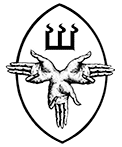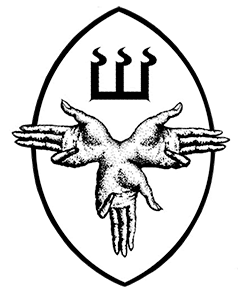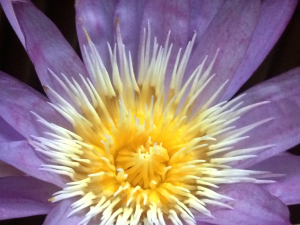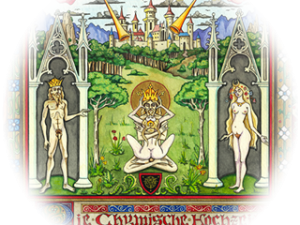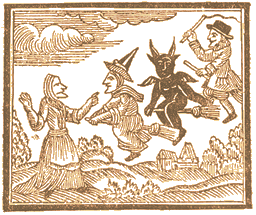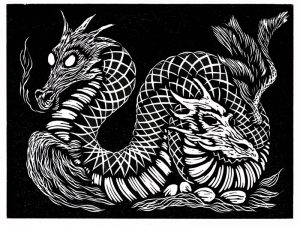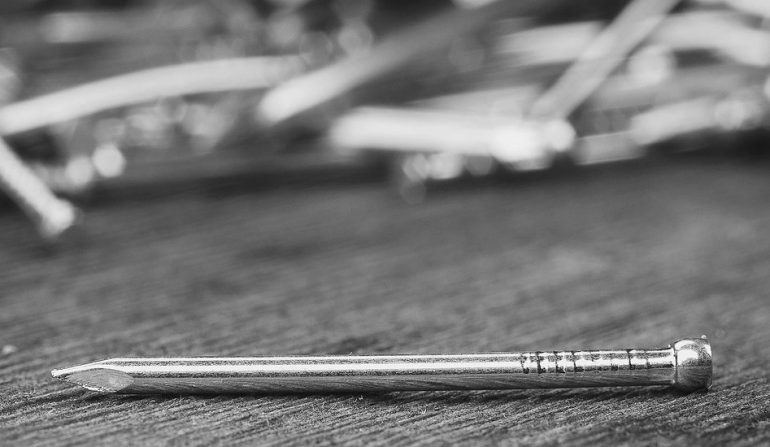
Within the witch’s craft many apparently mundane objects are considered to have both magical and mystical virtue, one example being the humble nail. Although some, on basis of morphology, ascribe to nails a phallic virtue, they also have a fixative power, i.e. the ability to bind one thing to another, for good or bane. Nails also partake in no small measure of the powers ascribed to their material, which is normally iron, that heavenly metal linked in the occult mind with blood and the virtues of redness.
When a thing is brought into contact with another it makes an alligation. The basis of alligation is that all things created, whether by the hands of man or nature, are bestowed by the Soul of the World with virtue, which is harnessed by bringing the virtuous object into contact with people/places/objects. Included in this is the binding of two things together in alligation by a nail, so that one might influence the other.
The thing or power being fixed by the nail to person, place or object can be manifold; even celestial powers corresponding to the time at which the nail was struck into its medium can be bound into workings. Herein we understand the basis of hammering various amulets into the lintel above the threshold, such as the apotropaic images of the sun, open hand or ubiquitous horseshoe.
Contrary to popular belief, nails are as protective as the horseshoes they affix. Indeed, Pliny the Elder advised hammering three iron nails, not horseshoes, into the threshold’s lintel to protect the home, likewise Paul Huson in Mastering Witchcraft advocated driving three iron coffin nails into the door, one above and two below in triangular formation. Similarly, protective enclosures are fashioned by striking nails into their four corners and wandering spirits are stopped by hammering nails into their coffins, whilst Romans averted plague and misfortune by driving nails into house walls. Thus is it axiomatic that the number of nails found within a horseshoe affects its potency, the more nails the greater the luck, although some hold true to the custom of fixing the shoe with three nails by means of three blows, alluding to the kinship betwixt nails and the number three.
Horseshoe nails have long been held to possess an array of powers, e.g. the crooked horseshoe nails hung as amulets about the necks of Irish children, and the horseshoe nails driven into the hearth by Teutonic peoples to draw back stolen property. Traditional witch Robert Cochrane recounted that “a horseshoe nail dipped in spring water was considered a prime remedy to use against the ‘little people’ when they grew bothersome”, which relies also on the well-known enmity betwixt the Fair Folk & iron.
Horseshoe nails were sometimes fashioned into rings, and in medieval France these were worn by the bride to draw favourable auspices. Elsewhere, they were deemed as protective against evil & ill luck as the horseshoe itself, and Cochrane alluded that such rings were known of & used within the witch cult.
Another type of circular ring fashioned by the bent nail is the cramp ring, said to cure cramp, epilepsy, rheumatism & palsy. Before the Reformation these were wrought of gold & silver and blessed by the Monarch on Good Friday. But when Queen Elizabeth abolished this practice, people still sought out such rings, and in Shropshire & Devonshire they made them from old coffin nails, “three nails taken from three coffins from three several churchyards” the old charm went.
The use of cramp rings to ward fits recalls Pliny’s assertion that “thrusting an iron nail into the spot where a person’s head lay at the moment he was seized with a fit of epilepsy, is said to have the effect of curing him of that disease” (Natural History). This practice is known of in my home county of Sussex, where it is recorded how an Isfield farm worker cured one his workmates in this very manner in the early 1900’s.
Thrusting iron nails into the ground is not confined to the curing of epilepsy, indeed it finds its way into a diverse array of folk practices, all of which work the principle of a nail’s insertion being an application of its force & virtue. Accordingly have nails been rubbed onto gums & hammered into trees to alleviate toothache, and stoked across warts before being driven into roads & stiles to be magically ‘picked up’ by passers-by; these examples working the principle of magical transference or ‘law of contagion’.
Some witches use a similar practice to fix celestial powers, especially that of the Polestar, into the earth by hammering a nail into the working site’s centre, thereby bringing the powers above to the world below. Scandinavians anciently knew the Polestar as “God’s Nail”, and others have called it the ‘Nail of the North’, referring to the old belief that the heavens are fixed into place by a jewel-headed nail, about whose axis they revolve. In remembrance of this the Scandinavians would hammer nails dedicated to Thor into the top of the central pillar supporting their house, in the same way witches hammer a nail into the stang’s foot, creating an underworld reflection of the Heavenly Nail.
In Siberian mythology the Nail of the North is atop a golden pole (the polar axis), which drives a giant mill grinding out riches, happiness & other worldly goods; this being evoked by the witches’ Mill that is danced about a central point. The Lapps also have an old legend that says when the Heavenly Nail is shot down by the bow of Arcturus, the heavens will fall & crush the earth, resulting in a fiery inferno.
The most familiar witch tradition concerning nails is their use to pierce the witch’s manikin with benevolent or malevolent intent, yet there is equal tradition in using blackthorn spines, which like nails have an innate warding virtue. Thorns are often used alongside or in place of nails in the magical arts, e.g. in the famed witch-bottle or being tied into the end of the curse cord in place of a rusty nail. We might thus consider them as ‘wooden nails’ fashioned by the green hand of the Faerie Smith, to which Schulke alludes in Viridarium Umbris when he says, “the Thorn is both punitive & binding, the Holy Nail of the Greenwood executing the grim sentence of Crucifixion at once harnessing the forces of binding & torment”; it is in the crucifixion that we discover the nail’s apotheosis.
Crucifixion & sacrifice by hanging upon a tree is not a motif exclusive to the Christian mythos, rather it is a fate met by many deathless mortals so as to grant eternal life, including “Prometheus, Adonis, Apollo, Arys, Bacchus, Buddha, Christna, Horus, Indra, Ixion, Mithras, Osiris, Pythagoras, Quetzalcoatl, Semiramis and Jupiter”4. We might add to this Odin, who by hanging from Yggdrasill died & entered the Underworlds so as to learn of otherworldly wisdom that could be mediated to the world of man.
The cross has been defined by Schulke as “the supreme magical formula of incarnation-sacrifice-apotheosis arising from the fixation of spirit into the four ways of matter”. Herein we might understand crucifixion as the binding of heavenly spirit to earthly flesh, or Light to Matter. The Cross of Matter in this instance signifies the material world’s four-fold division, whether into compass points, seasons, elements or similar. This is the underlying meaning of the Light-bearing, normally solar, god pinioned to the Cross, thereby fixing the Heavenly Fire into the flesh yet at the same time liberating it through Death.
Tradition has long held that the Light was fastened to the Cross by means of the binding & fixative nail. In Christian tradition the exact number of nails used has long been a matter of debate, one school of thought numbering them as four and another as three; within this simple article of belief resides a deep esoteric philosophy.
The Four Nails Of The Crucifixion
The commonest belief is that the Lightbearer was pinned to the cross by four nails, one in each palm & one in each sole. This belief is depicted in the “Coptic Cross”, which shows the Four Nails and the Cross itself, the centre being the Lightbearer’s Heart. In conflating the cross with the four primal directions we come to understand how the Heart is to be identified with the centre of the worlds; this being also the centre of the witch’s compass. Here we are reminded of the four rivers of blood that emanate from the four wounds, flowing to the corners of the world, and in this we find some similarity to the philosophy that informed the drawing & quartering of the hanged King, the four parts being buried at the corners of the sacred enclosure.
However, the total wounds are not four in number, but five, the fifth being the wound in his “side”, or more probably genitals, akin to that suffered by the Fisher King, which made him ‘lame’ & his land barren. Intriguingly, some depictions of the crucifixion show Jesus seated upon a sedile, which is a small seat attached halfway down the cross’s front to allow the genitals to be impaled by a nail, further confirming Jesus as an avatar of the Wounded or Sacrificial King of Light.
The Fisher King’s wound is made by the Bleeding Lance, identified by some with the Spear of Lugh, whereas Christ’s is given by the Spear of Longinus, which esoteric lore attests was forged by Tubal-Cain, avatar of the witch master. In piercing the Lightbearer’s Heart, the spear also pierces that of the heavens, revealing it as a simulacrum of the Heavenly Nail wrought by the hand of the gypsy fire god Tubalo.
The Three Nails Of The Crucifixion
The belief that Jesus was crucified by only three nails is known as triclavianism, which properly means “Three Keys”. The nails were struck one through each palm & one through both feet, forming a downwards-pointing triangle. But three nails or four, the wounds remain the same, and outstretched personify the crucified man-god impressed in Space, represented in the crossroads.
As an emblem of Jesus’ suffering, these nails represent ordeal & the acceptance of fate, i.e. the choice to accept what must be done, & the evolution resulting from engagement of life’s trials; it is in ordeal & sacrifice that spirit becomes liberated from flesh. This relates to the “removal of the Rose from the Cross”, for that which fixes spirit to the body can also be removed. Such is achieved through three alchemical initiations that work to ‘draw out’ the Nails, thereby allowing man’s divine nature to come down from its cross; the third & final initiation being the finding of the philosopher’s stone.
This ‘Christian’ symbol, sometimes appearing as three wooden spears, also occurs on amulets of solar deities. The arrangement is that of the Awen, i.e. Inspiration falling from the Heavens to Earth, equating the Nails with the Elemental Queens who pre-ordained the Sacrificial King’s death. This symbol thereby comes to represent not only the three-fold nature of the Awen & the three essences sacred to the Fate Queen, but also the IAO formula, the alchemical elements, the parts of the moon & so forth.
Some witches make this sign in their rites by holding high three splayed fingers. As the letter Shin, meaning “tooth”, it stands for Shaddai & is made by the priest’s hands during the Yom Kippur blessing (relating to the sacrificial scapegoat). Hargrave Jennings remarks that the English ‘broad-arrow’ (), which marks out royal property, is also symbolic of the Three Nails, the prominent middle arrow signifying the “Second (with feminine meanings) Person of the Trinity”. Such a symbol is also found in the Indian Trishul, the gypsy Trushul, the Algiz rune, the trident & the three-pronged rake used by some witches as a tool of ‘the Goddess’.
These Three Nails also codify a downward-pointing triangle upon the Four-fold Cross, alluding to the relationship betwixt the forces represented in the Triangle & Cross / Square. Also revealed is the pattern of the Tau, and we might here ruminate upon the altar of the stang, which Evan John Jones describes as “the symbolic altar of sacrifice, the old Tau cross of the kerm oak from which hung the dying body of the God / King sacrifice”. In its forked top & base we observe the nail-pierced hands & feet, and by hammering a nail into the butt we allude to the Fourth Nail of Romany myth, the hammer itself being redolent of the Tau Cross.
In the doctrine of triclavianism, the Heart of the Lightbearer is wounded by a Fourth Nail, bringing the total stigmata to five. This Fourth Nail, forged in Romany mythology by a gypsy smith, refused to temper, and on discovering its fate was to impale Christ’s heart the Smith fled with it, his reward being eternal life within the body of the Moon. This red-hot ‘wandering’ nail is emblematic of Fire, the one element given to man, and the Blacksmith God; it is the Fourth Nail as the knife/ sword/ spear piercing the Heart of the man-god who hangs by Three Nails upon the Tau Cross, thereby slaying him.
Related to this is an old Neapolitan tradition of sorcerous evocation employing a triangle of nails about a fire & a black-handled knife. The triangle signifies “the crystallisation of Form out of Chaos”1 & denotes the three-fold Elemental Mothers, whereas the Knife as Fourth Nail represents the Goat-Footed Fire God. This may be rendered as a three-sided edifice spinning without motion upon a central axis, the middle point being the Knife, Spear, Sword or Heavenly Nail.
When discussing the St Duzac stone, Robert Cochrane specifies it featuring “what the archaeologists describe as three nails…they can be either nails or knives since three nails or three knives are used in certain forms of magical practice”. Some claim this a rite of cursing, but in truth it’s a remembrance of an old pagan custom for gaining the Fate’s blessings, thus inscribed next to the nails are three squares representing “three moons, which mean power over fate”; this custom is borne out by the following:
“Have you done as some women do, at certain times of the year spread a table with meat and drink and three knives, so that if those Three Sisters come, which the descendants of Antiquity and old foolishness called the Fates, they can regale themselves? Do you believe that those called the Sisters can help you now or in the future?”
—From the Confessor’s Manual (circa 900 CE)
“She who lays a table with three knives for the service of the Fates, that They may predestinate good things to those who are born there, shall do penance for two years.”
—From the Penitential of Bartholomew Iscanus, Of Magic (circa 1161-84).
The ‘Table of Fortune’ is traditionally held annually on the night of the calends, the table being set with food and Three Knives placed upon it as invitation to the Fates is made. Intriguingly, a similar boon is secured by hammering three nails into the earth to summon Three Kings, reified as those of biblical tradition, although some suggest this is a later gloss on an earlier pagan tradition. Of course, the Three Knives may be worked for retribution; the Fates spin many destinies. One old curse working this principle involves hammering three iron nails into a tree’s north face in triangular formation, naming the victim at each blow.
Although used to call up the Fates, nails paradoxically have tradition in warding their kin, the witches & faeries. Folklore holds that an iron nail or knife is especially repellent to faeries, and for protection can be carried upon the person when awake & driven into the bed-head when asleep. Bent nails in witch-bottles ward witches, nails driven into their footprints break their enchantments and scratching them with a nail deprives them of their power. Also, a nail-struck pig heart hung in the chimney, points outward, prevents witches from descending the flue, whilst a heart pierced with hawthorn barbs & nails is hung as a charm against witchery.
The nail-filled heart has further tradition as a malevolent charm, the nails placed to make the shape of the victim’s initials & hung to roast in the chimney, or placed in a pot besides the fire. Cuts of meat are similarly employed, using the old “tis not this meat that I mean to prick/burn” formula, just as poppets of wax & cloth are pierced by virtue of thorn and nail, reminding us of the ordeal engendered by the Nails of the Crucifixion.
The most potent nails, which old Somerset lore stipulates “twas never touched by hand or twas no good”, are those fashioned by the god-like blacksmith, master of the heavenly fire, and waters in which such nails are tempered (‘forge water’) have long been regarded as potent philtres. Some became wary of the Blacksmith’s magical reputation, with a corpus of folklore asserting him in league with the Devil, whose symbol is the first work of the Blacksmith, the nail.
Having been forged by a gypsy smith, and having pierced Christ, it comes as little surprise that the crucifixion nails were said to have great power. Far more than three or four nails have surfaced through the years, and many tales have become attached to them, such as the one Gregory of Tours claimed was cast into the Adriatic to calm a storm & that fashioned into a bridle by St Helen for Constantine’s horse.
In this we have charted something of the humble nail from its mundane use as a charm binder to its apotheosis as the fixative binding the Lightbearer to the Cross of Time & Space. Yet it would be remiss to conclude this article without mentioning the Passion Flower, which recapitulates the mythos; the leaves recalling the lance piercing the Lightbearer’s side, the three stigma the nails of his crucifixion and the five anthers as the resulting five wounds. In working with this plant through the arts of philtre, suffumigation & charm we may come to further access the powers & mysteries traditionally hidden within these arcane symbols.
